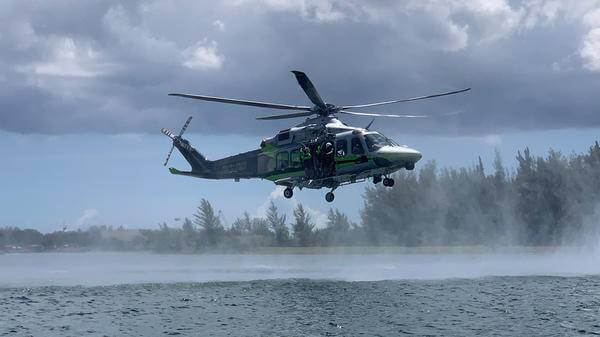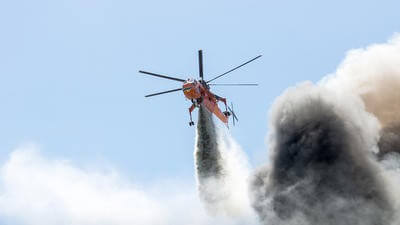Provider Profile: MDFR Air Rescue Bureau

Oliver Cuenca spoke to Captain Alex Vazquez, Officer-in-Command at Miami-Dade Fire Rescue’s (MDFR) Air Rescue Bureau, about his organization’s work
MDFR’s Air Rescue Bureau is a publicly owned emergency aviation provider serving Miami-Dade County in southern Florida. It provides a broad range of services, including air medical transport, search and rescue (SAR), and aerial firefighting support.
The bureau was formed in October 1985, at which point it consisted of a single Bell 412 helicopter operated by a team of three people: one pilot and two other flight crewmembers. The original goal of the service, explained Captain Alex Vazquez, the bureau’s Officer-in-Command, was to provide rapid patient treatment and transport to Jackson Memorial Hospital’s Ryder Trauma Center in the city of Miami.
“This single unit was operated out of Tamiami Airport in the south end of Miami-Dade County, and responded to any location within the county and its surrounding unpopulated areas,” he said.
“Over a short amount of time, the program proved to be a huge success,” continued Vazquez. “In order to keep the unit flying on a reliable 24/7 basis, a second Bell 412 was purchased to ensure that there would always be an available aircraft to respond, [and] with this purchase began the ‘special operations’ portion of MDFR Air Rescue.”
This second helicopter came equipped with a rescue hoist and cargo hook. The former enabled MDFR to respond to SAR and rescue hoist missions for the first time, while the latter allowed them to attach a Bambi Bucket to their aircraft and offer wildland firefighting support when necessary.
In 2000, a second base at Opa-locka Airport was opened to serve the north side of Miami-Dade County – leading to the purchase of two more Bell 412 helicopters to be stationed at the base.
The four helicopters served the county for almost four decades, before being phased out in favor of a new fleet of four Leonardo AW139s. The AW139s were ordered by MDFR in December 2019, and were introduced into service over the next year.
A modern service
The modern service continues to operate from the two bases at Opa-locka (Air Rescue South) and Tamiami (Air Rescue North) airports on a 24/7, year-round basis. It is funded through a general fund paid into by multiple municipalities in the area to support the service.
“Both bases are each operated by a crew consisting of a pilot and co-pilot,” explained Vazquez, “and two flight medic/crew personnel – who are both trained in all special operation applications, and advanced medical procedures.
“They are supported by the administration staff – that comprises the Air Rescue Bureau officer-in-chief, [who is] in command of the chief pilot, training officer, logistics officer, and a safety officer. MDFR Air Rescue also has a dedicated, full-time staff of eight aircraft technicians led by the aircraft maintenance supervisor,” he added.
The overwhelming majority (80 per cent) of callouts responded to by the bureau are air medical in nature
While MDFR provides a range of services, the overwhelming majority (80 per cent) of callouts responded to by the bureau are air medical in nature, Vazquez said.
MDFR responds to a range of medical missions, including a roughly equal number of callouts for strokes, traumas, and heart attacks, such as ST-segment elevation myocardial infarctions (STEMI). “Not all hospitals have the capability to attend to these alerts, and patients must be flown in to cut down the response time,” said Vazquez.
The agency also conducts interfacility transfers between hospitals – typically transporting a patient from a location in the Florida Keys chain of islands, to a more sophisticated Miami-Dade County-based hospital.

A flexible array of equipment
MDFR’s four AW139 helicopters are also fitted with a range of equipment to support its operations, described by Vazquez as a ‘full medical array’, including a Lund University Cardiopulmonary Assist System (LUCAS) to assist with cardiopulmonary resuscitation in remote areas.
“There is also a complement of rescue devices that can be accessed at any moment during flight,” continued Vazquez, “[including] a strop, a foldable backboard with hoistable encapsulating bag, and an extraction device for ambulatory victims. The aircraft also has the proper dive gear the medic can change into for any search and rescues over the Florida waterways.”
The aircraft also has the proper dive gear the medic can change into for any search and rescues over the Florida waterways
Smaller equipment, such as the items mentioned above, are kept onboard the aircraft to be ‘accessible from inside … without the need to land and reconfigure’, he added. However, some equipment may be removed prior to take-off if a helicopter is launching directly from base, and if the mission in question does not require them. For example, in the event of an SAR mission, the ‘patient stretcher will be taken out to allow for a better platform for the rescue basket or Stokes device to be secured to the floor’. Likewise: “Most excess weight will be removed from the aircraft if we were to conduct aerial firefighting operations using a Bambi Bucket. This includes all of the items previously mentioned,” said Vazquez.
A broad range of training
MDFR crews – both pilots and medics – have to undergo ‘assigned recurrent training’ on a regular basis, Vazquez explained: “These are specific maneuvers … or drills that need to be conducted periodically. The timelines for these specific actions range from every 30 days to once a year, [and] ensure that the pilots and medics remain not only current but proficient.”
These drills vary from general aviation skills to technical hoist work, as well as ‘radio communications, navigation, the use of night vision goggles (NVG), diver operations, SAR, and medical skills’.
MDFR’s flight medics, said Vazquez, are recruited from within the Miami-Dade Fire Rescue Department. “Candidates must be a department-protocol certified paramedic for two years, [as well as] a certified advanced open water diver,” he explained.
Additionally: “Those that are qualified must pass a department-administered flight medic entrance exam. Those candidates that score 80 per cent are placed on an eligibility list and will subsequently be selected based on seniority when the need for flight medics arises.”

Serving the community
The agency also works in collaboration with ‘other county assets’, such as MDFR’s fireboat and ground units, and can ‘contact any police, coast guard, or ranger unit’ via radio to assist in its efforts. MDFR also has the ability to ‘patch all radio channels together to assist any unified command structure’, explained Vazquez.
A current project is to supplement ground units and command with live feed from the helicopters’ camera systems
“A current project is to supplement ground units and command with live feed from the helicopters’ camera systems, [while] an array of antennae are being installed across the county to provide uninterrupted video from within our response territory,” he added.
The bureau aims to provide a consistent level of provision throughout the year, regardless of season, fluctuations in tourist numbers, and threats such as wildfires. “While the weather changes are not as drastic in South Florida … Everglades fires will be more prevalent at certain times of the year, and the unit is in increased readiness when the humidity and heat index may indicate favorable conditions for fires,” explained Vazquez.
Likewise, during the peak tourist season, when there is a greater likelihood of callouts, the agency will have at least two aircraft ‘in service, and at an increased level of readiness’.

August 2023
Issue
Combat search and rescue is adapting to stay relevant for today’s needs; medevac capabilities must develop to be faster and more robust to accommodate the modern requirements; drones are being used to deliver essential medical supplies and it won’t be long before full human transport recovery becomes the norm; based off the popular Black Hawks, the Firehawk is able to perform a in a variety of roles for the provision of firefighting services; and we have all of our regular content to keep you engaged with the industry experts and specialists in the special missions sector across the globe.
Oliver Cuenca
Oliver Cuenca is a Junior Editor at AirMed&Rescue. He was previously a News and Features Journalist for the rail magazine IRJ until 2021, and studied MA Magazine Journalism at Cardiff University. His favourite helicopter is the AW169 – the workhorse of the UK air ambulance sector!

